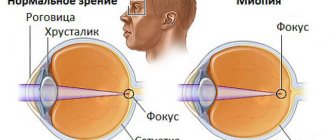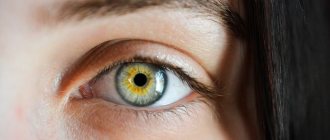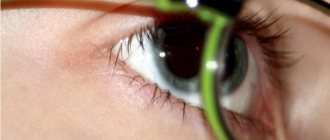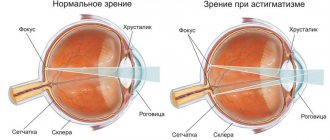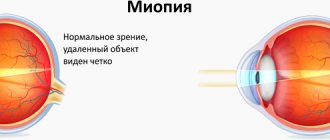How does a person see if he has -3 vision?
In the world of illusions, this is precisely the state in which a myopic person with vision of -3 resides.
He perceives objects not as they really are. The outlines of figures at a distance become unclear. Large objects appear small and vice versa. The skin on people's faces appears smooth, almost perfect. To some extent, with myopia, the world is transformed. Small details and roughness disappear. The surroundings become blurry. It’s like turning down the sharpness in a photo or shading the contours of the picture.
For comparison:
- At -1, a person practically does not feel discomfort. He just doesn't see very far.
- At -2, it is difficult to distinguish large inscriptions at a distance of 40-50 meters.
- Vision -3 turns near into distant. Text on a computer screen, for example, can no longer be read.
What is myopia:
| A defect in the eye in which light rays are focused not on the retina, but in front of it, is called myopia. The longer the eyeball, the worse a person sees far away. The higher the level of myopia, the more side effects appear. At vision -3 they become noticeable. |
The disease progresses in any case. This is especially dangerous in childhood. Then vision deteriorates rapidly because the child grows quickly. Computers, tablets, phones and other gadgets aggravate the disease by placing excessive strain on the eyes. The danger is a decrease in vision by more than 1 diopter per year.
Degrees of myopia
Mild refractive errors, up to 3 diopters, are classified as first degree myopia. Myopia of up to three diopters can be practically invisible if people’s activities are not related to information processing, working with small details, etc.
The danger of such a pathology is that if the disease is ignored, it continues to progress. Without taking any actions aimed at restoring normal blood circulation to the organs of vision, vitaminization, a person risks the health of his eyes. Myopia with diopters of 3 or more units, up to 6 diopters, is classified as moderate.
The second, average degree of myopia, significantly reduces the quality of life of patients, since they cannot see normally without glasses or contact lenses. This form of myopia also leads to certain restrictions, including professional activities. At this stage, diseases accompanying the main diagnosis appear. With myopia of more than 3 diopters, changes in the fundus of the eye, retinal dystrophy, etc. are often recorded.
The third degree of myopia is characterized by significant changes in the shape of the eye. Myopia of 6 or more diopters negatively affects the condition of the retina, often accompanied by astigmatism. Young men with such vision may have limited suitability for military service. If myopia is 6 or more than 12 diopters, category “D” is assigned (unfit).
What is farsightedness: glasses for vision correction
Currently, a huge number of people around the world suffer from poor vision. This disease can be a consequence of any diseases, congenital pathology, or exposure to external factors. Everyone knows that there is such a thing as farsightedness, but few can give a clear definition of this condition. Most older people wear glasses (glasses plus or minus). At the same time, some people see better in the distance, while others see closer. This is determined by the characteristics of the refractive ability of the eyeball.
Farsightedness, for which glasses should be selected by an ophthalmologist, does not pose a great danger to humans. However, to prevent further vision deterioration, it is very important to choose the right glasses or lenses. In any case, consulting a doctor is simply necessary. Presbyopia is of great interest. It is a type of farsightedness (hypermetropia), observed in old age and develops against the background of aging of the body. Let us consider in more detail what hypermetropia is, glasses as the main method of vision correction, farsightedness, glasses plus or minus.
What is farsightedness
There is such a thing as eye refraction. This is the ability of various structures of the eyeball to transmit, refract light and focus an object. Normally, in a healthy person, when light rays pass through the vitreous body, cornea, and lens, they converge at one point strictly on the retina. Farsightedness is a change in the refraction of the eye, characterized by the fact that the image is focused behind the retina. As for myopia, this is a completely opposite concept. With myopia (nearsightedness), the object is focused in front of the retina.
There is a misconception that a farsighted person always sees well in the distance and poorly near. In most cases, farsightedness is characterized by the fact that a person sees poorly from any distance, but is better able to distinguish objects located in the distance. It has been established that approximately every fourth person on Earth has farsightedness. An interesting fact is that with presbyopia, people have really good distance vision. This is explained by the fact that the lens is relaxed and there is no refractive pathology.
Etiology and mechanism of development of farsightedness
When choosing glasses for plus or minus, as well as lenses, the doctor must know for what reasons farsightedness develops. The main causes of farsightedness include:
- reduced size of the eyeball in the longitudinal direction;
- aging of the body;
- childhood.
When using glasses, not everyone knows that farsightedness is most often a consequence of a decrease in the size of the eyeball. In this case, only the size in the anterior-posterior direction matters. This condition may be due to congenital characteristics. It is important that almost all children are farsighted. This is due to the immaturity of the eyeball. As all organs and systems grow and develop, the eyes increase in size.
It is imperative to know that in the presence of presbyopia in elderly people, the lens is not able to adequately change its curvature. Of great importance is the fact that this condition begins to form at a young age. Around the age of 40-50, a person begins to see poorly up close. In addition, over time, the eye's ability to accommodate is lost.
The mechanism for the development of farsightedness is quite simple. The human eye is an optical system that includes various structures, from the cornea to the lens. The accuracy of the transmission of an object is affected not only by the size of the eye, but also by the optical power of the lens and cornea. The lens is similar to a biconvex lens. Normally, the lens becomes even more convex, which increases the refraction of rays that fall exactly on the retina. With farsightedness, the power of refraction of light by the lens decreases.
Types and degrees of farsightedness
Points plus or minus? This issue is decided by the attending physician. In this situation, it is an ophthalmologist. Glasses or contacts are almost always needed when vision is impaired. Glasses for farsightedness are largely determined by the degree of hyperopia. There are 3 degrees of farsightedness:
- weak;
- average;
- high.
Weak differs in that up to 2 diopters are required to normalize vision. In the second degree, 2 to 4 diopters are missing. With the third (high degree of hyperopia) the eye needs more than four additional diopters. When choosing glasses for plus or minus, you need to know that a diopter is a unit of measurement of the intensity of light refraction by a lens. An important fact is that glasses for farsightedness are needed only if there is degree 2 or 3. In mild cases, the organ of vision can independently correct its function.
Before choosing glasses, you need to remember that farsightedness varies. The first type is physiological hypermetropia. It is typical for children. There is also congenital hypermetropia. In such a situation, refraction in children is not normalized. With a pronounced degree of hypermetropia, strabismus may occur. If left untreated, this condition can lead to significant loss of vision in one eye. This is called amblyopia.
Vision correction with glasses
There are various ways to correct vision. If you are farsighted, you can improve your vision with glasses or contacts. Optical stores have a huge assortment of glasses (glasses plus or minus). What glasses should I buy if a person has hypermetropia? To do this, you need to determine its degree. This procedure is performed in a doctor's office. The patient sits down on a chair, and at a distance of 6 meters from him there is a special board with letter designations. The board should be well lit. The letters on it are arranged in several lines. In the first line they are large in size, but as you go down their size decreases.
The left and right eyes are examined in turn. During the examination, one eye remains open, and the other is covered with a special shield. The doctor shows the letters starting from the top line. The last correctly named line will indicate the person’s visual acuity. The next stage is the selection of points. To do this, a person is given a set of biconvex lenses; if the subject sees well through them, then a conclusion is made about the presence of farsightedness.
After this, the doctor provides lenses. Each subsequent lens refracts the rays more strongly. They stop when a person begins to see objects poorly. The degree of hypermetropia is determined by the last most convex glass, with which the person still saw well. At the next stage, when farsightedness is determined, the question of whether glasses are a plus or a minus is resolved. If you are farsighted, you need to buy glasses that are plus.
Why myopia occurs - causes of refractive error
If a person was born with normal vision, then it cannot change overnight. This is preceded by a certain period of instability, such as with false myopia. Or vision is affected by processes associated with a hereditary factor. When one or both parents suffer from myopia, the child is at risk. With congenital myopia, an abnormal structure of the eyeball is usually noted due to prematurity, intrauterine hypoxia, and an infectious disease suffered by the child’s mother in the first trimester of pregnancy.
What should children's vision be like? Normally, children are born farsighted, and the shape of the eyeball is shortened. Congenital myopia, more than 3-6 diopters, implies an elongated eyeball. When refracted, light rays do not reach the retina. Such disorders are dangerous for the overall development of children, since the formation of the visual analyzer occurs incorrectly.
Most often, myopia of 3-6 diopters is diagnosed in primary schoolchildren and adolescents. It is believed that myopia of this form is associated with increased visual stress, but in most cases a predisposition to the disease is recorded. Predisposition can be determined in children during routine medical examinations and then the child’s exercise and rest regime can be completely reconsidered. This means that you will need to regularly train the accommodative muscle with exercises, exercise on machines and follow all preventive instructions from the doctor.
Problems with myopia
It's bad enough to see this is already a difficulty. Myopia progresses over time. If you do nothing and continue to strain your eyes, complications will not keep you waiting. In this disease they can be as follows:
- Stretching of retinal vessels. As a result, microcirculation of blood flow in the capillaries is disrupted. In the worst case, retinal detachment occurs. This means complete loss of vision.
- Cataract.
- The appearance of flies and floating dots before the eyes.
- Formation of Fuchs' spot due to retinal hemorrhages (severe case).
- Myopia with -3 causes a lot of psychological problems.
In women, wrinkles appear early due to frequent squinting. The quality of life decreases. Performing some activities in everyday life becomes difficult. It is impossible to drive a car, type, or watch TV. There is one more unpleasant moment. A person with such vision has difficulty hearing. Because the brain focuses more on looking at objects.
Return to contents
Diopters and percentages
The concepts of refraction and visual acuity should not be confused, which often happens when people hear examination results from a doctor. The first category is expressed in diopters, while the second has no unit of measurement. When we talk about diopter, we mean lenses in which the correction will be maximum. Thus, a patient who distinguishes only 3 lines sees at 30% (0.3). The specialist begins to select optics in which the tenth line will be visible.
If the maximum was achieved with a lens of minus 0.75 diopters, then it is not a fact that it will suit everyone with an indicator of 30%. Even with vision of 0.3, different people will need corrective agents with different optical powers. It depends on the disease (myopia, farsightedness, astigmatism) and other reasons.
In addition, diopters are not the only parameter. A lens with the same diopter, but a different curvature or cylinder axis, may be suitable for patients whose visual acuity varies.
Sharpness and refraction do not directly depend on each other, although if the latter deviates, the value of the former decreases. But it is impossible to calculate how much vision will decrease in percentage terms when changing by a certain number of diopters. It is also impossible to find a connection between the direct influence of the vigilance index on refraction.
Converting optical power to other quantities is meaningless. This will not give a universal number for everyone and will not help you choose optics yourself. You will still have to see an eye doctor.
Symptoms
How does a person with myopia see? He has difficulty distinguishing house numbers, bus numbers, inscriptions, and people's faces. Myopia manifests itself in the form of two main symptoms:
- Deterioration in vision of distant objects. Along with this, people see well up close.
- The outlines of objects at a distance are blurry and indistinct. At the same time, when a person squints, objects become clearly visible.
In addition, myopia may be accompanied by other unpleasant symptoms: headache, dryness and pain in the eyes, tearing, impaired twilight vision, and the appearance of spots before the eyes.
Important! Myopia can lead to retinal detachment and complete loss of vision.
What and how to see with minus 2 vision
With vision of -2 diopters, a person sees close objects quite well, and with good eye accommodation, he does not even need to use glasses. As a rule, an ophthalmologist prescribes glasses for distance vision.
A certain discomfort is noticeable when watching TV: small details become less noticeable, which is why you have to strain. When working with a computer, some details are also not noticeable. At dusk, vision deteriorates noticeably.
Minus 3
Features of vision with this degree of myopia:
- a person sees only the first lines in Sivtsev’s table;
- any distant objects appear blurry;
- watching TV shows is difficult, small details and teletext are completely invisible;
- due to the blurring of small details, a nearsighted person has to read a book at a close distance;
- twilight vision is impaired, the person sees silhouettes of objects.
Minus 4
Further deterioration of vision occurs:
- the patient has to squint his eyes all the time in order to see the world around him more clearly;
- small objects are not visible even at a relatively close distance;
- working with a computer is difficult, a person cannot see small text;
- Due to the noticeable blurring of contours, it is difficult for the patient to recognize acquaintances.
Minus 5
With myopia -5, a person sees clearly only those objects that are located at a distance of no more than 10 m. Everything else is visible as if in a fog. The patient can record silhouettes and their movement.
A person with myopia -5 recognizes people by their voice. His hearing becomes more acute: this ability helps him better navigate in space.
Minus 6
With myopia of -6 diopters, a person sees only nearby objects. The rest are recorded in the form of vague large spots and silhouettes.
Causes of myopia and its degree
Not seeing a friend at a bus stop, getting on the wrong minibus, losing something and looking for it for a long, long time, etc. This is what it means to have vision - 3. It becomes impossible to live without glasses.
There are three levels of myopia:
- Low myopia - vision up to -3 (comfortable stage).
- Moderate – ranging from -3 to -6 (uncomfortable, but acceptable).
- High degree – from -6 and more (complex myopia, dangerous).
Why does the optical power of the eye not correspond to its length? There are several reasons for this:
- High eye pressure can cause a rare disease - juvenile glaucoma. Develops in babies in the prenatal state. Reaches up to 5-6 diopters.
- 10% of people suffer from weak sclera (connective tissue). As a result, myopia not only develops rapidly, but develops mega-rapidly. Especially against the background of reduced immunity. It all starts at the age of three and can last up to 35. Vision reaches 20-25 diopters with an “apple” length of 32 mm. This is a very unfortunate case. Heredity plays the main role here.
- In most people (65%), myopia develops due to overwork of the eye muscles. Poor nutrition, poor light, infrequent blinking when reading, watching videos leads to elongation of the eye.
- The last two factors can be present simultaneously. This will be a mixed type of myopia. The length of the eye is approximately 26-27 mm, vision is 7-8 diopters.
The following may also contribute to reduced visibility:
- head injury;
- high intracranial pressure;
- other eye diseases (strabismus, etc.);
- lack of vitamins, consumption of alcohol, nicotine, drugs.
- Knowledge of the degree of development of the disease affects the tactics and success of treatment.
Return to contents
False myopia
Adults who have never had vision problems may experience unpleasant symptoms due to excessive visual stress, which is a sign of false myopia. How to recognize this? When reading or writing text, letters begin to double, blur, and the eyes quickly get tired when watching videos, working with information on the screens of a laptop, tablet, etc. In this case, there is a high probability of a spasm of accommodation, the so-called false myopia, which is successfully treated with mydriatic drugs that dilate the pupil, as well as compliance with the work and rest regime. Typically, with such a disorder, vision drops by 2 or 3 diopters.
But you should not think that false myopia is not dangerous; it can eventually turn into true. Although the causes of true myopia (and it can be not only more than 3-6, but above 12 diopters) are different, and they are associated with the special structure of the eye, a genetic predisposition to the disease, which can result from inattention to one’s health.
Causes
Critical loads on the organs of vision are the main reason. The structure of the eyes ensures their long-term functionality only when the muscles of the eye lens are relaxed.
In this position, a person clearly sees objects at a distance of about 0.5–5 meters. This is the kind of vision that was required for hunting and daily life.
To clearly see objects closer or further from this zone, you need to change the thickness of the lens, and to do this, strain your muscles excessively. If you work in this mode for a long time, the muscles become exhausted, atrophy and cannot change the thickness of the lens, the image becomes unclear, and visual acuity decreases.
We spend a lot of time at the computer or reading books, without maintaining physiological distance.
Table. Other causes of visual impairment.
If a person sees objects well at close range, but at a distance they are blurry, then he has symptoms of myopia (myopathy), the image is focused in front of the retina. There are several reasons for this phenomenon: in adolescence, the development of the eyeball was disrupted and it lengthened.
Deviations in the shape of the cornea, traumatic significant displacement of the lens. In older people, myopia appears due to sclerotic changes in the lens.
Medicine distinguishes the following types of myopia.
There are several stages of myopia, which are formed according to the degree of vision deterioration.
- weak – up to minus 3 D;
- average – from minus 4 to minus 6 D;
- high – from minus 7 to minus 20 D.
Vision minus 3 is characterized by the fact that the membranes of the eyeball itself are stretched, which, in turn, leads to their thinning.
Of course, this process also negatively affects the vessels responsible for feeding these structures. Microcirculation inside the organ is disrupted.
The discrepancy between the strength of the optical system of the eye and its length can be caused by the following reasons:
- irregular shape of the eyeball;
- weakness of the accommodative muscle;
- insufficient lighting;
- reading in transport;
- increased intraocular pressure;
- scleral weakness;
- avitaminosis;
- non-compliance with visual hygiene;
- hormonal disorders;
- incorrectly selected glasses;
- hereditary predisposition;
- weakening of the body;
- prolonged exposure to a computer screen.
Reasons for development
Stretching of the membranes of the visual organ, which results in decreased vision, leads to disruption of the microcirculation of the eye. The cause of myopia is often a hereditary predisposition. Congenital myopia is characterized by an anomaly of eyeballs that are larger than normal. In this situation, the genetic factor plays an important role: if one or both parents had myopia, then the child may also be born with this pathology.
The consequence of myopia can be retinal detachment, the end result of which is often complete blindness.
How to improve vision with myopia -3 D
Surgery is not indicated for all people. There are less risky ways. One of them is gymnastics.
| With the help of exercises, you can sometimes completely restore your vision. The classes are aimed at relieving eye strain and slowing down myopia. There are many types of exercises for this. |
Here are the simplest of them:
- "Blind Man's Bluff." While sitting, close your eyes tightly for 5 seconds. Open your eyelids wide at the same time. Perform 10 times.
- "Near and Far" . You need to draw a dot on the window. Look first at it, then through the glass at distant objects. Riding a bicycle helps to imitate this exercise (you constantly have to look either under the wheels or far ahead). Repeat – 12 times.
- "Eight". With our eyes we draw the number 8. From top to bottom and back, then horizontally.
- "Kind with healthy" . It is suggested to read the book with one eye open, then the other.
It is important to do gymnastics regularly, in a calm home environment and for a very long time.
If myopia is vision a minus or a plus?
The main reason why a person begins to wonder whether myopia is a plus or a minus is a decrease in visual acuity. Before the appearance of disorders, usually rarely does anyone become interested in the qualitative indicators of their vision; this
In this article
- If myopia is vision a minus or a plus?
- Optical apparatus of the eye
- Why are the terms “plus” and “minus” used?
- What is responsible for focusing vision?
- What types of myopia are there?
- Factors that provoke myopia
- Diagnosis and correction of myopia
quite understandable from a common everyday point of view. However, understanding the workings of the eye's optical system could help prevent vision problems and maintain eye health. In short, myopia is a minus, and in this case the ophthalmological term quite clearly conveys the feeling of inconvenience that this disease causes to the patient.
Treatment is not only possible, but necessary!
When the diagnosis of “vision 0.3” is confirmed, most likely, the doctor will prescribe you to wear lenses or special glasses - in most cases this is a prerequisite for correcting vision impairment.
If the ophthalmologist deems it appropriate, he will only allow you to wear glasses or contacts when reading, working on a computer, or watching TV. In cases where this is not effective enough, glasses or lenses are prescribed for constant wear, but the doctor must verify this through additional research.
By the way, “vision 0.3” does not mean at all that you can go to an optician and buy glasses with a diopter of 0.3. Doctors say that this is the biggest misconception of people who are diagnosed with vision problems. Only an ophthalmologist can choose the most suitable glasses, taking into account the diopter value that will be most effective with vision 0.3. It is impossible to do this correctly on your own!
The effectiveness of laser vision correction for myopia above 3-6 diopters
Getting rid of glasses forever is the dream of many myopic people, and with the development of laser technology, such dreams are increasingly becoming a reality. How long does the effect of the correction last? The result of laser vision correction depends on the characteristics of the refractive error, the presence of concomitant diseases and the age of the patient. The optimal period for correction is age from 22 to 35 years. What should vision be like before surgery? It is important that the patient's vision is stable for several years, because as myopia progresses, the result may not be long-term. For myopia of 3 or more diopters, laser surgery is quite effective. After this, the patient receives the vision he had with the best possible correction with glasses or lenses. A popular question is: if before the operation you were wearing glasses one hundred percent, then after the operation what kind of vision will it be - one hundred percent or not? Yes, one hundred percent, without lenses or glasses, such a person will see all 10 lines. The laser intervention technique is selected by the doctor, who takes into account the characteristics of the patient’s cornea. The main difference between the methods is the depth of impact.
For patients with thin corneas, PRK is recommended; in other cases, the following options are available: Lasik and Superlasik, Lasek, Smile. Before the operation, a map is drawn up indicating the parameters of the effect on the cornea; all processes are controlled automatically, so the operation is safe and the human factor is reduced to a minimum. Myopia of more than 12 diopters can be corrected by implanting an intraocular lens.
How is myopia treated?
Myopia is an incurable disease. If a child is diagnosed with -3 vision, then there will be no improvement. At best, it will remain the same, at worst, it will decrease even more. Therefore, children's vision should be checked regularly, from birth. The initial symptoms of myopia in a baby can be noticed at 12 months. At three years old, the doctor will prescribe corrective optics.
Many parents neglect glasses, indulging their children’s complexes. And in vain. After all, they slow down myopia and help avoid complications. The same, in fact, applies to adults as well. If myopia is stable, you may still wear contact lenses.
Another method is refractive therapy. Special night lenses have been created that gently change the curvature of the cornea during sleep. Today, hardware vision treatment and laser correction are also available and popular. They have a lot of good reviews. In difficult cases, phakic lenses are implanted and the lens is replaced.
Farsightedness - is it a plus or a minus?
One of the most common diseases of the visual organ is farsightedness or, as it is also called, hypermetropia. People also often have a pathology called myopia. But only those patients who have encountered these diseases can accurately identify the difference between them. Although, this is important for every person to know.
What are farsightedness and myopia: the main differences
People often wonder what myopia and farsightedness are, since these are completely two different pathologies. But one thing they have in common is impaired visual acuity due to pathological changes in the eyeball, retina and cornea. It turns out that in order to see images clearly at different distances, the optical axis must have a precise direction and focus specifically on the retina. When this happens, the light rays transmit information about the image through the lens and cornea, and then are sent to the retina, where a nerve impulse is formed. This light beam then travels through the optic nerves and reaches the visual regions of the brain. So, the difference between farsightedness and myopia:
- Myopia and also myopia. In this case, it is difficult for the patient to see an image located in the distance. But he sees those objects that are located nearby as clearly as possible. The pathology is characterized by a change in the eyeball in the form of elongation. Because of this, the light ray is refracted in front of the retina, rather than on it. It follows from this that refraction occurs in the vitreous body. The cause of the development of myopia may be a hereditary factor, injury to the cornea, ciliary muscle of the eye or lens.
- Farsightedness. With hypermetropia, a person clearly sees objects that are close, but what is far away is blurry. Therefore, for example, to read a book, a person must move it forward a little. Otherwise, it is impossible to see the letters. With hypermetropia, the eyeball becomes smaller, it seems to be flattened, which is why the ray is refracted outside the retina. Pathology occurs against the background of age-related changes and due to disorders in the eyeball. Senile farsightedness is called presbyopia. Quite often, pathology develops due to prolonged sitting at the computer, reading small print, and working with the smallest details. All this occurs due to overstrain of the eyeball, as a result of which accommodation weakens and the lens becomes excessively dense. Consequently, elastic properties are lost, and many elements of the organ atrophy.
Farsightedness in childhood
IMPORTANT! Farsightedness is present in children from birth and this is the norm. It turns out that this happens because the visual organ goes through elementary physiological stages of growth. As a rule, by the age of 3, the eyes are fully formed and hypermetropia disappears. If in the future the child shows complaints, it means that the disease is actively developing. Therefore, before school age, parents are simply obliged to ensure that the baby’s eyes do not overstrain. That is, it is necessary to prohibit sitting for a long time in front of the TV and playing computer games.
Symptoms of farsightedness
As has already become clear, with hypermetropia a person has difficulty distinguishing objects located nearby. But this is not the only sign of the disease. Farsightedness is accompanied by fatigue of the visual organs, frequent lacrimation, burning, dryness, photophobia and even pain syndromes in the eyes, in the bridge of the nose and even in the head.
How to distinguish between minus and plus
People often cannot understand whether farsightedness is a plus or a minus? The answer is obvious: hypermetropia is designated as a plus (+), and myopia as a minus (-). The doctor checks the level of visual acuity using a special table and ophthalmic devices. The patient sits at a distance of five meters from this table and closes one eye. The ophthalmologist shows letters and numbers of a certain size, on the basis of which the degree of minus or plus is determined. As a rule, the patient has either myopia or farsightedness, but it also happens that both diseases are combined. This pathology is called astigmatism. It occurs due to eye injury, diabetes or high blood pressure. And also as a complication after surgery.
How to treat farsightedness
Today, methods such as microsurgery and laser correction are used to treat hypermetropia. These methods allow you to get rid of the disease forever. But not every person agrees to such radical methods, so vision can be restored with the help of drug therapy, special exercises and other things. As for childhood, it is definitely necessary to initially apply restorative measures. So, farsightedness - how to restore vision:
- First of all, the ophthalmologist prescribes the wearing of contact lenses or glasses marked “+”. Glasses do not cure, but maintain the visual apparatus in the condition in which it is. That is, the disease does not progress. It is up to the patient to decide what to choose - lenses or glasses, since their effect is the same. The only question is price and convenience. For example, it is problematic to play sports with glasses; they disrupt the aesthetics of the appearance and do not allow peripheral vision to manifest itself. But they are cheaper and do not require special care. Lenses are much more expensive, require maintenance, and are inconvenient to insert and remove. But on the other hand, they do not interfere with active life and, most importantly, allow the patient to see normally both in front of him and to the side.
- Vitamin therapy. Everyone knows that vitamin A, B12, C, as well as beta-carotene, selenium and zinc are essential for visual acuity. A person should receive these beneficial substances both from a natural source and with the help of tablets and drops. Be sure to eat vegetables, berries and fruits.
- The treatment program includes exercises with special training glasses and special exercises for the eyes.
- Today, laser therapy, vacuum massages, and electrical stimulation are used to restore visual acuity.
- Drops. Usually with farsightedness there is a burning sensation, pain and dryness. In this case, it is necessary to use special drops. For example, "Taufon". In many cases, the doctor prescribes Quinax or Yodurol, Oftan-katachrome or Claritin. In fact, there are a huge number of drops, but they are prescribed exclusively for individual indications. Drops should definitely be used by those who decide to wear contact lenses.
- Physiotherapeutic measures are required. Today it is possible to visit a physiotherapy office or use equipment at home.
What is presbyopia
Presbyopia is not as well-known as farsightedness or nearsightedness, but it is also a very common phenomenon known as “senile vision.” Presbyopia is the gradual loss of the eye's ability to focus on nearby objects.
Presbyopia typically begins in people in their forties and continues to get worse until around age 65.
Common symptoms include:
- a tendency to hold reading text away from the eyes to make letters clearer;
- eye strain or headaches after reading or working with text.
Prevention
To prevent the development of myopia, you should adhere to the following rules:
- the illumination in the room should be within normal limits, using artificial or natural light from the window;
- limiting the amount of time spent in front of a computer, TV, phone, tablet;
- eating food that contains sufficient amounts of vitamins, microelements, and minerals necessary for the normal functioning of the visual organs;
- use of multivitamins;
- annual use of physiotherapeutic procedures;
- frequent walks in the fresh air, where concentration of gaze on nearby objects is not required, oxygen from the air enters the brain and eyeballs in sufficient quantities;
- timely treatment of systemic diseases;
- annual preventive examination by an ophthalmologist, especially if the patient has a chronic eye disease;
- maintaining good hygiene to prevent infection in the eyeballs.
If myopia of -3 diopters is detected, it is recommended to consult an ophthalmologist. He will identify the cause of the condition and prescribe treatment, which should be strictly adhered to. If myopia progresses, the doctor will prescribe additional therapy, laser or surgery. To prevent complications from the disease, it is recommended to follow the rules of prevention suggested by your doctor.
Why are the terms “plus” and “minus” used?
When describing farsightedness (hyperopia) or nearsightedness (myopia), the concepts plus or minus are used, they mean what optical lenses are used to achieve focusing of the image.
Initially, ophthalmology used spectacle lenses that had either a convex or concave shape.
A convex lens that collects light rays, which is necessary for farsightedness, has always been called positive, hence the expression “vision plus.” A concave lens, which scatters light rays in case of myopia, is called negative in ophthalmology - hence the expression “minus vision”.
The amount of deviation from the norm is indicated in special units - diopters, which show what power lens is needed for complete correction.


